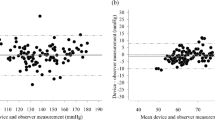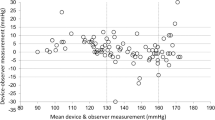Abstract
The accuracy and precision of the Finapres in recording rest and exercise blood pressure compared with the intra-arterial (aortic and brachial) and random-zero sphygmomanometer methods was assessed in 84 ischaemic patients in three different studies. Firstly, comparison at rest with the aortic intraarterial pressure in 50 ischaemic patients demonstrated that the Finapres systolic (136.5 ± 21.1 vs. 129.3 ± 19.0 mmHg;p < 0.001) and mean (92.4 ± 13.4 vs. 90.7 ± 11.4 mmHg;p < 0.001) arterial pressures were higher and diastolic pressures lower (70.4 ± 11.5 vs. 71.5 ± 9.8 mmHg;p < 0.001). The reproducibility of the Finapres and invasive method was similar for systolic (4.6% vs. 4.0%), diastolic (2.8% vs. 2.7%) and mean (3.3% vs. 3.0%) blood pressures. Second, in seven subjects studied twice at rest and during 4 min supine bicycle exercise, the exercise increase in blood pressure was greater on the Finapres compared with the brachial intra-arterial pressure (systolic +10.2 ± 6.3 vs. +3.6 ± 9.8 mmHg; diastolic +9.6 ± 11.1 vs. +0.2 ± 2.1 mmHg;p = 0.02 for each); however, at steady-state the peak/trough differences in pressure between the methods were similar. Thirdly, compared under rest conditions, to random zero sphygmomanometer (RZO), the Finapres systolic pressure was higher (6.8 ± 3.5 mmHg) and diastolic pressure lower (−6.0 ± 1.9 mmHg). During upright bicycle exercise, the difference between the Finapres and RZO in systolic blood pressure increased at each level of exercise (+14.3 ± 4.2, +17.9 ± 4.0 and +22.2 ± 4.1 mmHg respectively at each exercise stage:p < 0.01). For RZO, diastolic blood pressure fell as exercise workload increased whereas Finapres diastolic blood pressure increased on exercise (3.1 ± 2.6, 7.0 ± 2.1 and 8.1 ± 2.0 mmHg respectively:p < 0.01). Thus there were systematic differences between the values recorded by the Finapres and proximal blood pressure methods and limited agreement in the rest to exercise increments related to light exercise. Calibration of the Finapres values in terms of the other methods is limited by the variable relationship to these related changes in arterial distensibility.
Similar content being viewed by others
References
van Montfrans GA, van der Hoeven GMA, Karemaker JM, Wieling W, Dunning AJ. Accuracy of auscultatory blood pressure measurements with a long cuff.Br Med J 1987;295: 354–355.
Tuijanmaa V. Determination of blood pressure level and changes in physiological situations: comparison of the standard cuff method with direct intra-arterial recording.Clin Physiol 1989;9: 373–387.
Gravlee GP, Brocksmidt JK. Accuracy of four indirect methods of blood pressure measurement with haemodynamic correlations.J Clin Monit 1990;6: 284–298.
Penaz J, Voight A, Teichmann W. Beitrag sur fortlaufenden indirekten Blutdruckmessung.Zschr Inn Med 1976;31: 1030–1033.
Molhoek GP, Wesseling KH, Settels JJM, van Vollenhoven E, Weeda HWH, de Wit B, Arntzenius AC. Evaluation of the Penaz servo-plethysmomanometer for the continuous non-invasive measurement of finger blood pressure.Basic Res Cardiol 1984;79: 598–609.
Parati G, Casadei R, Groppelli A, di Rienzo M, Mancia G. Comparison of finger and intra-arterial blood pressure monitoring at rest and during laboratory testing.Hypertension 1989;13: 647–655.
Imholz BPM, van Montfrans GA, Settels JJ, van der Hoeven GMA, Karemaker JM, Wieling W. Continuous non-invasive blood pressure monitoring: reliability of Finapres device during the Valsava manoeuvre.Cardiovasc Res 1988;22: 390–397.
Smith JJ, Kampine JP. Pressure and flow in the arterial and venous system. In: Smith JJ, Kampine JP, eds.Circulatory Physiology. 3rd ed. Baltimore: Williams and Wilkins, 1990; 89–109.
O'Brien E, Petrie J, Littler W, de Swiet M, Padfield PL, O'Malley K, Jamieson M, Altman D, Bland M, Atkins N. The British Hypertension Society protocol for the evaluation of automated and semi-automated blood pressure measuring devices with special reference to ambulatory systems.J Hypertens 1990;8: 607–619.
Association for the Advancement of Medical Instrumentation.American National Standard for Electronic or Automated Sphygmomanometers. Washington, DC; AAMI, 1987.
Bland JM, Altman DG. Statistical methods for assessing agreement between two methods of clinical measurement.Lancet 1986;i: 307–310.
Remington JW, Wood EH. Formation of peripheral pulse contour in man.J Appl Physiol 1956;9: 433–442.
O'Rourke MF. The arterial pulse in health and disease.Am Heart J 1971;82: 687–702.
Van Egmond J, Hasenbos M, Crul JF. Invasive versus noninvasive measurement of arterial pressure.Br J Anaesthesiol 1985;57: 434–444.
Smith NT, Wesseling KH, de Wit B. Evaluation of two prototype devices producing noninvasive, pulsatile, calibrated blood pressure measurement from a finger.J Clin Monit 1985;1: 17–29.
Kermode JL, Davis NJ, Thompson WR. Comparison of the Finapres blood pressure monitor with intra-arterial manometry during induction of anaesthesla.Anaesth Intens Care 1989;17: 470–486.
Imholz BPM, Wieling W, Langewouters GJ, van Montfrans GA. Continuous finger arterial pressure: utility in the cardiovascular laboratory.Clin Auton Res 1991;1: 43–53.
Boehmer RD. Continuous, real-time, non-invasive monitor of blood pressure: Penaz methodology applied to the finger.J Clin Monit 1987;3: 282–287.
Rowell LB, Brengelmann GL, Blackmon JR, Bruce RA, Murray JA. Disparities between aortic and peripheral pulse pressures induced by upright exercise and vasomotor changes in man.Circulation 1968;37: 954–964.
Idema RN, van der Meiracker AH, Imholz BP, Man in't Veld AJ, Settels JJ, Wiesseling KH. Comparison of Finapres non-invasive beat-to-beat finger blood pressure with intrabrachial artery pressure during and after bicycle ergometry.J Hypertens 1989;7: S58-S59.
Dorlas JC, Nijboer JA, Butijn WT, van der Hoeven GMA, Settels JJ, Wesseling KH. Effects of peripheral vasconstriction on the blood pressure in the finger measured continuously by a new non-invasive method (the Finapres).Anaesthesiology 1985;62: 342–345.
Kroeker EJ, Wood EH. Comparison of simultaneously recorded central and peripheral arterial pressure pulses during rest, exercise and tilted position in man.Circ Res 1955;3: 623–632.
O'Rourke MH, Kelly RP, Avolio AP, Hayward CS. Potential for reversing the ill-effects of aging and of arterial hypertension on central aortic systolic pressures and on left ventricular hydraulic load by arterial dilator agents.Am J Cardiol 1989;63: 381–441.
Author information
Authors and Affiliations
Rights and permissions
About this article
Cite this article
Silke, B., Spiers, J.P., Boyd, S. et al. Evaluation of non-invasive blood pressure measurement by the Finapres method at rest and during dynamic exercise in subjects with cardiovascular insufficiency. Clinical Autonomic Research 4, 49–56 (1994). https://doi.org/10.1007/BF01828838
Received:
Accepted:
Issue Date:
DOI: https://doi.org/10.1007/BF01828838




